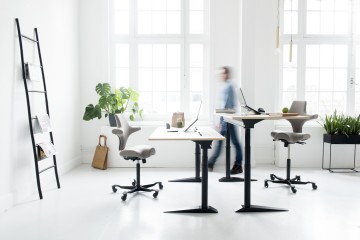Our solutions
Back
How do I choose the right office chair?
Today's office chairs are generally all adjustable in height, which is mandatory for any office chair, to suit the specific user, their tasks and preferences.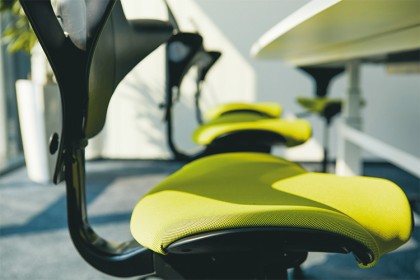
When choosing an office chair, always keep the following basic criteria in mind:
An ergonomic office chair has improved comfort and flexibility. With these chairs it is possible to adjust the seat height, seat depth, lumbar support and/or backrest. However, not every chair is equally suitable for your work. The longer you carry out your work while sitting, the more important it is that you have a comfortable office chair.
Adjustability is very important
If you have a shorter length, the seat should not be too deep and an office chair with a low gas spring is recommended (the gas spring is the cylinder with piston under the seat of the office chair). In addition, a footrest can also be an extra addition to your workplace.
If you are a bit taller or have a higher weight, it is recommended that the chair offers extra support. Someone who is taller or heavier often opts for a weighted gas spring to increase the load capacity.
1. The sitting time
Studies show that it is a good idea to regularly alternate between sitting and standing work. Sitting is not called the new smoking for nothing! Can't you avoid doing sedentary work for a longer period of time? Then we recommend that you choose an ergonomic office chair.An ergonomic office chair has improved comfort and flexibility. With these chairs it is possible to adjust the seat height, seat depth, lumbar support and/or backrest. However, not every chair is equally suitable for your work. The longer you carry out your work while sitting, the more important it is that you have a comfortable office chair.
2. The physique
Most standard office chairs are made for users with a height of 1.80 meters and have a maximum load of 110 kilograms. This also means that there are many employees who do not sit well in such a regular office chair, such as people who are shorter, taller and/or heavier. It is important for them to pay attention to the following:Adjustability is very important
If you have a shorter length, the seat should not be too deep and an office chair with a low gas spring is recommended (the gas spring is the cylinder with piston under the seat of the office chair). In addition, a footrest can also be an extra addition to your workplace.
If you are a bit taller or have a higher weight, it is recommended that the chair offers extra support. Someone who is taller or heavier often opts for a weighted gas spring to increase the load capacity.
3. The type of work
Finally, you have to make sure that your office chair suits your work. The more precise and specific the work is, the more adjustment functions you need to be able to sit properly. If you often change tasks, look carefully at the options for adjusting the chair. Do you mainly work from home? Then it is just as important to ensure that you have a good sitting position there. With more than 25 years of experience in the field of ergonomic workplace design, we can help and advise you at all times with the design of your office workplace or home workplace - for you or your employees.
The most important settings of an office chair explained
We have a range of office chairs that have various functions and mechanisms – so that a dynamic sitting position is encouraged. Below we explain the most important functions of a good office chair. In this way we want to show you how an ergonomic office chair provides extra support for your body or helps to prevent a wrong sitting position.
How to set your office chair:
1. Adjusting the seat height:
An important feature of a good office chair is the seat height adjustment. Sitting properly starts with bringing your office chair to the right height.
A seat that is too high can cause pinching of the lower legs. The blood supply to your legs is reduced and a sleeping feeling can occur in your legs and/or feet.
A seat that is too low results in a leaning forward sitting position. In this way, the muscles in your spine and back are unnecessarily strained. If the seat of your office chair is not correctly adjusted, this is quickly compensated with your posture. And that is always accompanied by a less ergonomic sitting position and therefore unnecessary strain.
Advice: Create an angle of 90° between your lower and upper legs.
A seat that is too high can cause pinching of the lower legs. The blood supply to your legs is reduced and a sleeping feeling can occur in your legs and/or feet.
A seat that is too low results in a leaning forward sitting position. In this way, the muscles in your spine and back are unnecessarily strained. If the seat of your office chair is not correctly adjusted, this is quickly compensated with your posture. And that is always accompanied by a less ergonomic sitting position and therefore unnecessary strain.
Advice: Create an angle of 90° between your lower and upper legs.
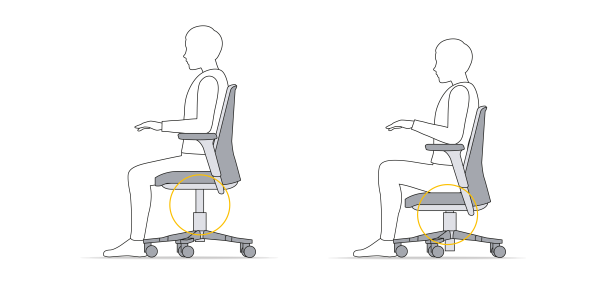
2. Adjust seat depth
Seat depth refers to the distance between the seat and the back of your knee. A responsible seat depth prevents the blood supply to the legs from being prevented. and that the backs of the knees are put under minimal stress.
Advice: Place 2 to 3 fingers between the back of your knee and the edge of your office chair.
Advice: Place 2 to 3 fingers between the back of your knee and the edge of your office chair.
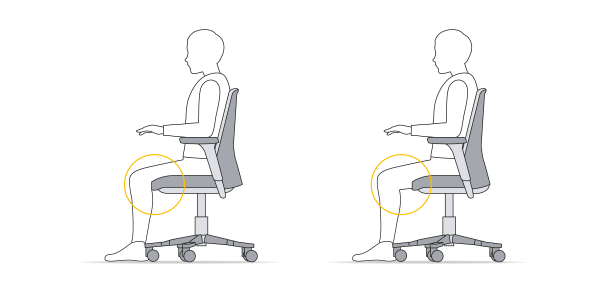
3. Adjust backrest
The backrest should ensure that you are encouraged to adopt an upright sitting position. For this purpose, a lumbar support is often added at the bottom of the seat.
The back must be continuously supported by the backrest of your office chair. Even if you assume the wrong position, the backrest should provide support to reduce the risk of overload. By means of lumbar support (support in the lower back) you adopt an active posture, your lower back is less stressed and you reduce the risk of physical complaints.
Recommendation: Adjust the lumbar support of the backrest so that it is at the height of the belt.
The back must be continuously supported by the backrest of your office chair. Even if you assume the wrong position, the backrest should provide support to reduce the risk of overload. By means of lumbar support (support in the lower back) you adopt an active posture, your lower back is less stressed and you reduce the risk of physical complaints.
Recommendation: Adjust the lumbar support of the backrest so that it is at the height of the belt.
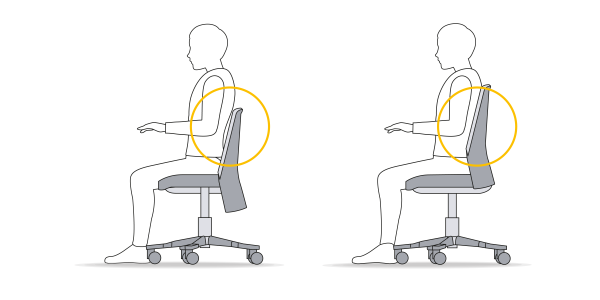
4. Adjust armrests
Armrests are there to prevent you from slumping. Armrests often have the option to move forwards, backwards and sideways and to turn. You can set this at your own discretion.
In addition, armrests are advised to use to relieve the neck and shoulder muscles. However, make sure they are adjustable in height and depth. Several studies have shown that they are only beneficial if they are properly adjusted (Shah 2017; Zhu and Shin 2012).
Recommendation: Adjust the armrests so that the angle between the upper and lower arms is 90° with your shoulders relaxed.
In addition, armrests are advised to use to relieve the neck and shoulder muscles. However, make sure they are adjustable in height and depth. Several studies have shown that they are only beneficial if they are properly adjusted (Shah 2017; Zhu and Shin 2012).
Recommendation: Adjust the armrests so that the angle between the upper and lower arms is 90° with your shoulders relaxed.

5. A headrest
A headrest is not mandatory, as it normally only supports your head when you lean back.
However, for users with specific health conditions, large users and in 24/7 environments, an adjustable headrest can be beneficial to reduce continuous and repetitive muscle activity.
However, for users with specific health conditions, large users and in 24/7 environments, an adjustable headrest can be beneficial to reduce continuous and repetitive muscle activity.
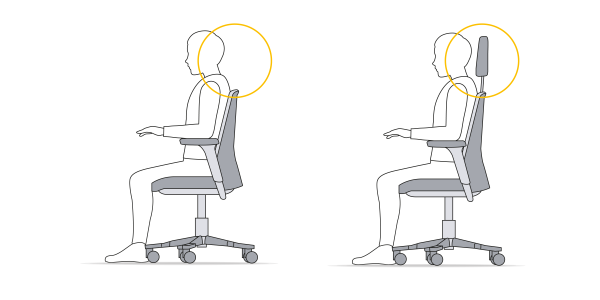
6. Adjust seat mechanism
Finally, the chair mechanism is very important for a good and active sitting position. A good chair offers you the functionality to switch between static and dynamic use. In order for the dynamic function to work well for you, it is necessary that you can properly adjust the counter pressure to suit your individual weight.
There are many different chair mechanisms used in office chairs to reduce physical stress, encourage movement, or both at the same time. Studies and arguments can be found for all these chair mechanisms that prove their effectiveness for one or more aspects of sitting. The common basic mechanisms are shown in the figure alongside.
Alternative concepts
In addition to the different mechanisms and core features of good office chairs, there are alternative concepts such as exercise balls and different seating forms such as saddle chairs that can encourage dynamic sitting. While exercise balls are only a short-term alternative to office chairs (for example, for a few minutes a day), due to missing core functions, saddle chairs can be used throughout the working day under certain circumstances. However, existing standards for seats are often not met by these alternatives, which is sometimes less due to the suitability of the solution than to the limitations of these standards.
Which type of chair you prefer to choose mainly depends on your tasks, way of working and personal comfort. That is why we offer you a well-selected range of seating solutions.
There are many different chair mechanisms used in office chairs to reduce physical stress, encourage movement, or both at the same time. Studies and arguments can be found for all these chair mechanisms that prove their effectiveness for one or more aspects of sitting. The common basic mechanisms are shown in the figure alongside.
Alternative concepts
In addition to the different mechanisms and core features of good office chairs, there are alternative concepts such as exercise balls and different seating forms such as saddle chairs that can encourage dynamic sitting. While exercise balls are only a short-term alternative to office chairs (for example, for a few minutes a day), due to missing core functions, saddle chairs can be used throughout the working day under certain circumstances. However, existing standards for seats are often not met by these alternatives, which is sometimes less due to the suitability of the solution than to the limitations of these standards.
Which type of chair you prefer to choose mainly depends on your tasks, way of working and personal comfort. That is why we offer you a well-selected range of seating solutions.
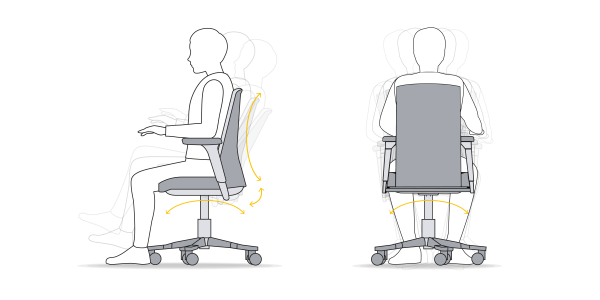
Finally, there are a number of other factors that are also important when choosing an ergonomic office chair:
1. The substrate
Take into account the surface of your working environment. The material of the wheels determines how easily the office chair will roll on any surface. For example, hard plastic wheels are suitable for surfaces such as carpet, while soft wheels are more suitable for tile floors or linoleum floors.
2. Appearance
Ask yourself whether the appearance of the chair still plays a role. We have many different designs in assortments. In addition, in most of our range you can also determine the color yourself. Because perhaps you think it is important that the chair matches your (home) work environment or matches the company colors?
3. Budget
It will apply to everyone that you also keep in mind what you want to spend on the chair. An ergonomic office chair does not necessarily have to be very expensive: there are certainly good ones in a lower price range. However, the more options you want on a chair, the more expensive it will become. Would you like more information about the (price) structure of your ideal office chair? Please contact one of our specialists, they will be happy to help you.
Take into account the surface of your working environment. The material of the wheels determines how easily the office chair will roll on any surface. For example, hard plastic wheels are suitable for surfaces such as carpet, while soft wheels are more suitable for tile floors or linoleum floors.
2. Appearance
Ask yourself whether the appearance of the chair still plays a role. We have many different designs in assortments. In addition, in most of our range you can also determine the color yourself. Because perhaps you think it is important that the chair matches your (home) work environment or matches the company colors?
3. Budget
It will apply to everyone that you also keep in mind what you want to spend on the chair. An ergonomic office chair does not necessarily have to be very expensive: there are certainly good ones in a lower price range. However, the more options you want on a chair, the more expensive it will become. Would you like more information about the (price) structure of your ideal office chair? Please contact one of our specialists, they will be happy to help you.
Would you like to know more about ergonomic working?

Good and active sitting
Active sitting is a way of working with an office chair, regularly changing...

16 tips for an ideal workplace
An ergonomic workplace promotes the comfort and productivity of VDU workers....
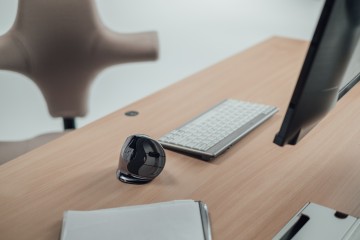
Whitepaper: Designing workstations
In this article you will find a quick guide to making your workplace more...
Need help? We're here for you
Look at our FAQ or contact us
Many customers preceded you
Read about their experience with BakkerElkhuizen
Select your country and language
